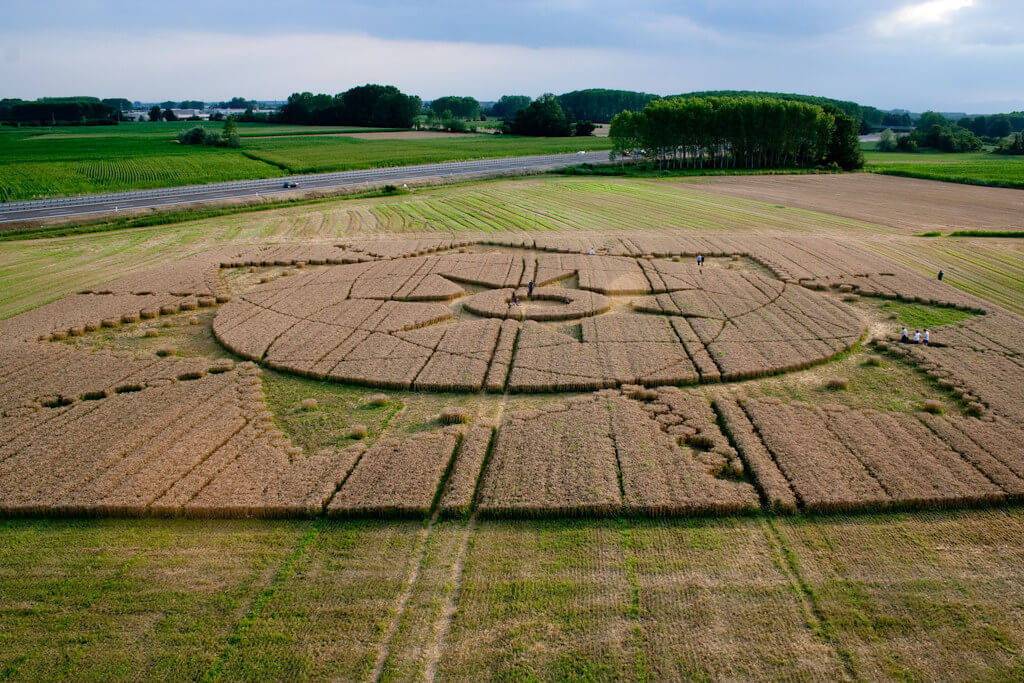The story of the mysterious crop circles that captivated the world in the late 1970s had an unexpected twist. Doug Bower and Dave Chorley, two ordinary individuals armed with only a simple set of tools, shocked the community of ufologists and paranormal enthusiasts when they confessed to creating the enigmatic patterns that had baffled experts for years. The revelation upended long-held beliefs about the origins of these intricate formations, sending ripples of disbelief through the realm of paranormal research.
The Origins of a Puzzling Phenomenon
In the summer of 1976, fueled by a curious tale from Australia and a few pints, Bower and Chorley embarked on their unconventional journey of creating crop circles. Inspired by the Tully Saucer Nests in Australia, the duo, united by their passion for art, embarked on a venture that would leave an indelible mark on the history of crop circles. Their escapades, initially intended as a simple prank, soon spiraled into a complex web of intrigue and curiosity, leading to an unprecedented global phenomenon.
The Hoax Unveiled
As Bower and Chorley reveled in their escapades, their crop circles became a subject of intense speculation and wild theories, ranging from extraterrestrial visitations to supernatural entities. Their elaborate ruse, coupled with their knack for playing along with the various pseudo-scientific claims, amplified the mystique surrounding the phenomenon, blurring the lines between reality and speculation. Their carefully orchestrated game, including elaborate designs and orchestrated sightings, became a testament to their cunning and creative flair.
The Elaborate Prank Unfolds
In the midst of the fervor, Bower and Chorley’s methodical approach to creating crop circles remained steadfast, employing rudimentary tools and a keen eye for detail. Their artistic inclinations drove them to incorporate suggestions and criticisms into their designs, blurring the boundaries between reality and illusion. Despite their growing notoriety, their dedication to the craft and their mischievous exploits continued, fueling the ever-expanding mythos surrounding crop circles.
The Role of Technology in the Evolution of Crop Circles
Advancements in technology have sparked debates about the intricate designs and complexities of modern crop circles. Some researchers argue that the precision and intricacy of certain patterns suggest the involvement of sophisticated tools or equipment beyond what a simple board and rope could achieve.
Questions have emerged regarding the potential use of GPS devices or advanced surveying tools that could enable the creation of elaborate designs that surpass the capabilities of manual methods. However, skeptics counter that the fundamental essence of crop circles lies in their organic and handmade nature, dismissing the idea of technological intervention as a deviation from the essence of the phenomenon.
Cultural and Folklore Interpretations of Crop Circles
The cultural and folklore interpretations of crop circles have sparked discussions about the symbolic and spiritual significance attached to these enigmatic formations. Some researchers delve into ancient cultural beliefs, connecting crop circles to various folklore narratives and mythological motifs. Interpretations range from sacred symbols representing cosmic energies to signs of divine communication or celestial messages. Conversely, skeptics argue that cultural interpretations often veer into the realm of pseudoscience and myth, lacking empirical evidence to support the claims of mystical or supernatural origins of crop circles.
The Impact of Crop Circles on Agricultural Communities
The impact of crop circles on agricultural communities has become a subject of debate, particularly in regions where these formations frequently appear. Proponents highlight the potential economic benefits for local communities, such as increased tourism and heightened interest in the region’s agricultural heritage. Some argue that crop circle tourism can stimulate local economies and contribute to the promotion of regional cultural identity. However, critics express concerns about the negative impact on crops, citing instances of financial losses for farmers due to crop damage and disturbances caused by curious onlookers or researchers.
The Psychological and Sociological Significance of Crop Circles
Discussions on the psychological and sociological significance of crop circles have surfaced, exploring the effects of these formations on human perception and societal beliefs. Some researchers delve into the psychological impact on individuals who claim to have witnessed or interacted with crop circles, citing experiences of wonder, awe, or spiritual enlightenment.
Sociological analyses focus on the communal response to crop circle phenomena, examining the formation of belief systems, group dynamics, and collective interpretations within local communities. Skeptics, however, highlight the potential for mass hysteria, delusion, or communal reinforcement of unfounded beliefs in the absence of empirical evidence supporting supernatural claims.
The Ethical Implications of Crop Circle Hoaxes and Pranks
Ethical debates have emerged surrounding the perpetuation of crop circle hoaxes and pranks, raising questions about the impact on scientific credibility and public trust. Some argue that the deliberate creation of fake crop circles for entertainment or personal gain undermines genuine scientific research and contributes to the proliferation of pseudoscientific beliefs.
Ethicists highlight the importance of maintaining scientific integrity and promoting responsible inquiry into unexplained phenomena, emphasizing the need for transparency and honesty in the investigation and documentation of crop circle occurrences. However, proponents of creative expression argue that crop circle art and pranks contribute to cultural discourse and artistic innovation, advocating for a balanced approach that acknowledges the artistic value of such endeavors.
Statistics On Crop Circles In South Africa
- Crop Circle Incidence in South Africa: While crop circles have been predominantly associated with regions in Europe and North America, South Africa has also reported sporadic occurrences of these formations, particularly in rural agricultural areas such as the Western Cape and Free State provinces.
- Local Community Impact: Studies indicate that communities in South Africa, especially in regions where crop circles have appeared, have experienced mixed reactions to these phenomena. While some farmers have expressed concerns about crop damage and financial losses, others have leveraged the tourist interest in crop circles to promote local agritourism and cultural heritage, contributing to the socioeconomic development of the affected regions.
- Cultural Perceptions: Within the South African context, certain cultural groups and communities have attributed symbolic significance to crop circles, linking them to traditional folklore and spiritual beliefs. These interpretations often intertwine with local narratives of celestial communication, ancestral messages, or natural energy patterns, reflecting the diverse cultural tapestry of the region.
- Scientific Research and Documentation: Despite limited comprehensive studies specifically focused on South African crop circles, emerging research initiatives have aimed to document and analyze the characteristics of these formations within the local agricultural landscape. Efforts to collaborate with local researchers and institutions have facilitated the collection of data on crop circle patterns, crop damage assessments, and community responses, contributing to a more nuanced understanding of the phenomenon within the South African context.
- Public Awareness and Education: Various educational outreach programs and initiatives in South Africa have sought to increase public awareness and understanding of crop circles, emphasizing the importance of critical thinking, scientific inquiry, and evidence-based analysis. By engaging with local schools, communities, and agricultural organizations, these efforts aim to demystify misconceptions surrounding crop circles and promote a balanced approach to exploring their origins and implications within the broader context of natural and human-made phenomena.
After years of meticulous planning and executing their intricate crop circle designs, the duo eventually decided to reveal the truth behind their elaborate prank. Despite presenting over 200 unique crop circle designs as evidence, their confession was met with skepticism from those deeply entrenched in the study of crop circles. Their legacy, a product of whimsical creativity and shared experiences, continues to remain a testament to the enduring power of human imagination and ingenuity.




